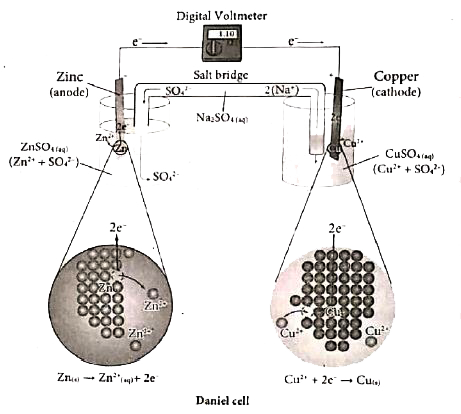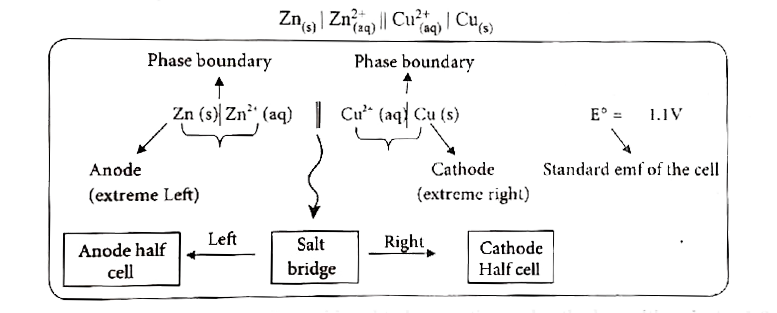Describe the construction of Daniel cell. Write the cell reaction.
Text Solution
The separation of half reaction is the basic for the construction of Daniel cell. It consists of two half cells.
Oxidation half cell: The metallic zinc strip that dips into an aqueous solution of zinc sullphate taken in a beaker.
Readuction half cell : A copper strip that dips into an aqueous solution of copper sulphate taken in a beaker.
Joining the half cell : The zinc and copper strips are externally connected using a wire through a switch (k) and a load (example : volt meter). The electrolytic solution present in the cathodic and anodic compartment are connected using an inverted U tube containing a agar - agar gel mixed with an inert electrolyte such as KCl,Na2SO4 etc. The ions of inert electrolyte do not react with other ions present in the half cells and they are not wither oxidised (or) reduced at the electroldes. The solutions in the salf bridge cannot get poured out, but through which the ions can move into (or) out of hte half cells.
When the switch (k) closes the circuit, the electrons flows from zinc strip to copper strip. This is due to the following redox reactions which are taking place at the respectivel electrons. The Zn2+ ions enters the solution and the electrode, i.e., zinc is oxidised to Zn2+ ions and the electrons.
The Zn2+ ions enters the solution and the electrons enter the zinc metal, then flow through the external wire and then enter the copper strip. Electrons are liberated at zinc electrode and hence it is negative (−ve).
Zn(s)→Zn2+(aq)+2e− (loss of electron - oxidation)
Cathodic reduction :
As discussed earlier, the electrons flow through the circuit from zinc to copper, where the Cu2+ ions in the solution accept the electrons, get reduced to copper and the same get deposited on the electrode. Here, the electrons are consumed and hence it is positive (+ve)
Zn(s)→Zn2+(aq)+2e− (loss of electron - oxidation)
Cathodic reduction:
As discussed earlier, the electrons flow through the circuit from zinc to copper, where the Cu2+ ions in the solution accept the electrons, get reduced to copper and the same get deposited on the electrode. Here, the electrons are consumed and hence it is positive (+ve).
Cu2+(aq)+2e→Cu(s) (gain of electron - reduction)
Salt bridge : The electrolytes present in two half cells are connected using a salt bridge. We have learnt that the anodic oxidation of zinc electrodes results in the increase in concentration of Zn2+ in solution. i.e., the solution contains more number of Zn2+ ions as compared to SO2−4 and hence the solution in the anodic compartment would become positively charged. Similarly, the solution in the cathodic compartment would become negatively charged as the Cu2+ ions are reduced to copper i.e., the cathodic solution contain more number of SO2−4 ions compared to Cu2+.
Completion of circuit : Electrons flow from the negatively charged zinc anode into the positively charged copper electrode through the external wire, at the same time, anions move towards anode and cations are move towards the cathode compartment. This completes the circuit.
Consumption of Electrodes : - As the Daniel cell operates, the mass of zinc electrode gradually decreases while the mass of copper electrode increases and hence the cell will function until the entire metallic zinc electrode is converted in to Zn2+ or the entire Cu2+ ions are converted in to metallic copper.
Daniel cell is represented as
Zn(s)∣∣Zn2+(aq)∣∣∣∣Cu2+(aq)∣∣Cu(s)


|
Topper's Solved these Questions
- ELECTRO CHEMISTRYBOOK - FULL MARKSCHAPTER - ELECTRO CHEMISTRYEXERCISE - EVALUATE YOURSELF
7 Videos
- ELECTRO CHEMISTRYBOOK - FULL MARKSCHAPTER - ELECTRO CHEMISTRYEXERCISE - ADDITIONAL QUESTIONS - CHOOSE THE BEST ANSWER AND WRITE IT
110 Videos
- ELECTRO CHEMISTRYBOOK - FULL MARKSCHAPTER - ELECTRO CHEMISTRYEXERCISE - TEXTBOOK EVALUATION - CHOOSE THE CORRECT ANSWER
25 Videos
- COORDINATION CHEMISTRYBOOK - FULL MARKSCHAPTER - COORDINATION CHEMISTRYEXERCISE - Additional Question(5 Marks Question)
26 Videos
- HYDROXY COMPOUNDS AND ETHERSBOOK - FULL MARKSCHAPTER - HYDROXY COMPOUNDS AND ETHERSEXERCISE - ADDITIONAL QUESTIONS (Answer the following)
115 Videos
Similar Questions
Knowledge Check
Daniel cell is
Airreversible voltaic cellBreversible voltaic cellCreversible secondary cellDirreversible secondary cellIn a Daniel cell,
Athe chemical energy liberted during the redox reaction is converted to electrical energyBthe electrical energy of the cell is converted to chemical energyCthe energy of the cell is utilised in conduction of the redox reactionDthe potential energy of the cell is converted into electrical energy.In a Daniel cell,
Athe chemical energy liberted during the redox reaction is converted to electrical energyBthe electrical energy of the cell is converted to chemical energyCthe energy of the cell is utilised in conduction of the redox reactionDthe potential energy of the cell is converted into electrical energy.
